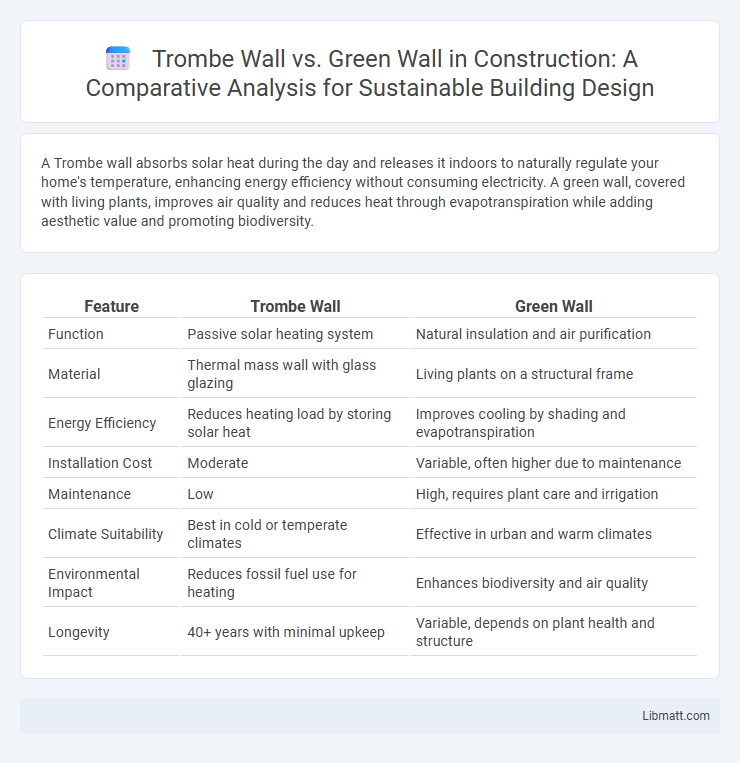A Trombe wall absorbs solar heat during the day and releases it indoors to naturally regulate your home's temperature, enhancing energy efficiency without consuming electricity. A green wall, covered with living plants, improves air quality and reduces heat through evapotranspiration while adding aesthetic value and promoting biodiversity.
Table of Comparison
| Feature | Trombe Wall | Green Wall |
|---|---|---|
| Function | Passive solar heating system | Natural insulation and air purification |
| Material | Thermal mass wall with glass glazing | Living plants on a structural frame |
| Energy Efficiency | Reduces heating load by storing solar heat | Improves cooling by shading and evapotranspiration |
| Installation Cost | Moderate | Variable, often higher due to maintenance |
| Maintenance | Low | High, requires plant care and irrigation |
| Climate Suitability | Best in cold or temperate climates | Effective in urban and warm climates |
| Environmental Impact | Reduces fossil fuel use for heating | Enhances biodiversity and air quality |
| Longevity | 40+ years with minimal upkeep | Variable, depends on plant health and structure |
Introduction to Trombe Wall and Green Wall
A Trombe wall is a passive solar building design feature that absorbs and stores solar heat through a dark, heat-absorbing surface behind a glass panel, releasing warmth gradually into the interior space. A green wall, also known as a living wall or vertical garden, consists of layers of vegetation planted directly on or supported by a structure, enhancing air quality and providing natural insulation. Both systems optimize energy efficiency but differ in function, with Trombe walls primarily focused on thermal energy retention and green walls emphasizing environmental benefits and biodiversity.
How Trombe Walls Work
Trombe walls function as passive solar heating systems by absorbing solar energy through a dark-colored, heat-absorbing surface behind glass, which then transfers stored heat to the interior space via conduction and natural convection. The air gap between the glass and the wall allows warmed air to circulate through vents, distributing heat evenly and maintaining consistent indoor temperatures. This thermal mass effect reduces heating costs by efficiently capturing and releasing solar energy throughout the day and night.
How Green Walls Function
Green walls function by using a layer of plants integrated into the building facade to improve air quality and provide insulation through evapotranspiration. These living systems absorb carbon dioxide and pollutants, reducing urban heat island effects while enhancing thermal regulation inside the building. The biological activity of green walls supports biodiversity and contributes to energy savings by lowering cooling and heating demands.
Energy Efficiency Comparison
Trombe walls utilize thermal mass and solar gain to passively heat interiors, significantly reducing heating energy needs during colder months. Green walls provide insulation and cooling benefits by shading building surfaces and promoting evapotranspiration, which can lower cooling energy consumption in warmer climates. Your choice between these systems depends on whether the priority is reducing heating or cooling energy demands, with Trombe walls excelling in energy efficiency for heating and green walls enhancing cooling efficiency.
Thermal Regulation and Comfort
Trombe walls use thermal mass to absorb and slowly release solar heat, enhancing indoor thermal regulation by maintaining stable temperatures throughout the day. Green walls contribute to comfort by providing natural insulation and evaporative cooling, reducing indoor heat and improving air quality. Your choice depends on whether you prioritize passive solar heating or cooling and air purification benefits.
Environmental Impact and Sustainability
Trombe walls use thermal mass to absorb and release solar heat, reducing reliance on heating systems and lowering carbon emissions, which enhances energy efficiency in buildings. Green walls improve air quality by filtering pollutants and provide natural insulation, contributing to biodiversity and urban cooling while sequestering carbon dioxide. Your choice between a Trombe wall and a green wall depends on whether you prioritize passive solar heating or enhanced ecological benefits for sustainable building design.
Cost and Maintenance Differences
Trombe walls typically require a higher initial investment due to materials like glass and masonry but benefit from low maintenance as they rely on passive solar heating without moving parts. Green walls often have lower upfront costs but involve ongoing expenses for irrigation systems, plant care, and potential structural reinforcement. You should consider your budget and long-term upkeep capabilities when choosing between the energy-efficient Trombe wall or the eco-friendly green wall.
Aesthetic and Design Flexibility
Trombe walls offer limited aesthetic and design flexibility due to their fixed masonry or concrete structure that primarily serves as a thermal mass, often resulting in a bulky appearance that blends best with traditional or rustic architectural styles. Green walls provide superior design versatility, allowing for diverse plant species, patterns, and integration with modern facades, creating dynamic living artworks that enhance both visual appeal and environmental benefits. While Trombe walls focus on passive solar heating with a functional aesthetic, green walls prioritize biophilic design and customizable greenery to complement contemporary and sustainable architecture.
Best Applications for Each System
Trombe walls are best suited for climates with significant solar exposure and seasonal temperature variations, as they capture and store solar heat to warm buildings naturally. Green walls excel in urban environments where improving air quality, insulating facades, and reducing heat islands are priorities, providing cooling benefits and enhancing biodiversity. Your choice depends on whether passive solar heating or environmental cooling and air purification is the primary goal.
Choosing Between Trombe Wall and Green Wall
Choosing between a Trombe wall and a green wall depends on your goals for energy efficiency and aesthetics. Trombe walls provide passive solar heating by absorbing and slowly releasing heat, ideal for colder climates where reducing heating costs is a priority. Green walls improve air quality, provide natural insulation, and enhance visual appeal, making them suitable for urban environments focused on sustainability and biodiversity.
Trombe wall vs green wall Infographic

 libmatt.com
libmatt.com